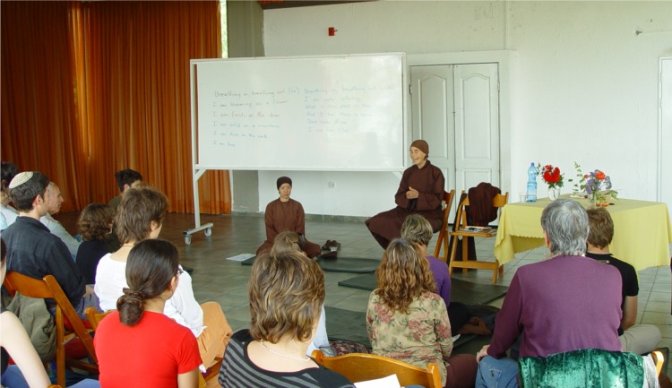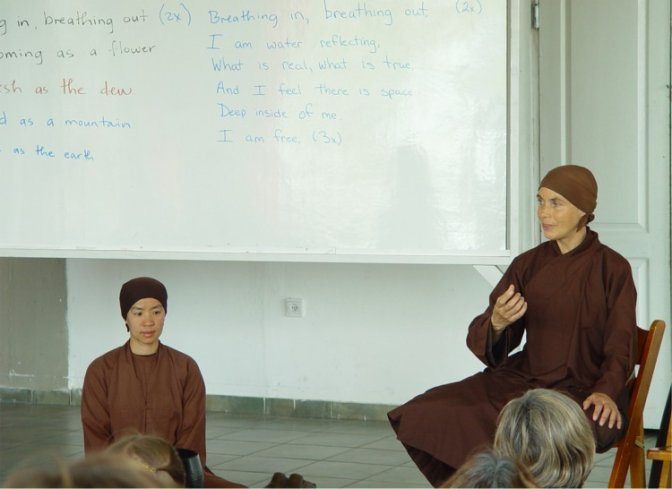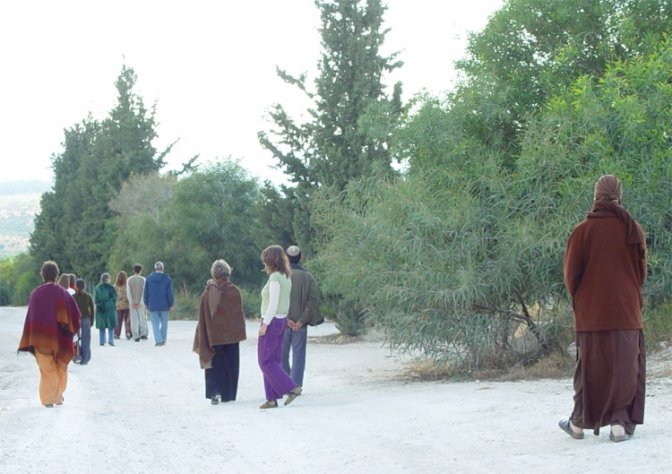Home > Oasis of Peace > Projects & Outreach > Doumia-Sakinah: The Pluralistic Spiritual Centre > Touching Peace
Touching Peace
A meeting with Sr. Gina Vess and Sr. Bik Nim of Plum Village
Tuesday 3 May 2005
All the versions of this article: [English] [עברית]

In the framework: “Peace Begins Here” - a series of meetings for peace and social change activists - we conducted a workshop facilitated by two two teachers from Plum Village – the meditation centre of the Vietnamese Zen master and peace activist Thich Nhat Hanh. With us were Sister Gina – a senior teacher and abbotess at one of the "hamlets" that make up Plum Village, and Sister Bik Nim, a young Vietnamese nun.
Sr. Gina began by speaking of the thought processes and energy we use when engaging in action. She explained that the complex society in which we live can be seen as a sum total of the energies contributed by each of its individual members. If we wish our society to be a more peaceful one, then security, tranquility, compassion, stability are essential components – both in the society and in ourselves. Strengthening these components in our consciousness will help us to bring about peace.
Since the day was intended not only for theoretical study, but also practice, Sister Gina asked us to reflect on the component of stability, and our ability to remain present without being pulled by emotions or drawn by the majority opinion. She said, "The most important tool that can help us to remain present in the moment is mindfulness of the breathing. Breathing is the connection between body and consciousness. Physical and mental presence gives strength and stability. While practicing mindfulness of the breathing there is awareness of the process of thinking and of emotions, by means of which it is possible to check whether we are feeding those processes that bring peace. "
Sister Gina explained that it is necessary to use aides memoire to remember this fundamental practice, since it rarely comes naturally. She recommended that we adopt sounds from our environment as cues to remember the practice, such as the ringing of a clock or a telephone. "While hearing its ring we can turn our awareness back to the breathing and return to full presence in the here and now."
Another of the practices that interspersed our meeting was slow mindful walking, in the manner practiced at Plum Village. While walking, we were instructed to be aware of the breathing, of the meeting between the foot and the ground, of the various colours, sounds and voices from the surroundings, and also of the thoughts and emotions inside us.
After our walk, we sat quietly for a meal. In Plum Village eating is also seen as a meditative practice. Although no one mentioned this fact during our seminar, people seemed to understand this anyway, and enjoyed their food in a contemplative way.
During the final part of the the meeting, opportunity was given the participants to ask questions and discuss issues connected with our work as peace activists.
In the discussion that developed, various participants spoke about the necessary but difficult challenge involved in encountering people who disagree with us or oppose us, and to develop understanding and compassion in situations of conflict.
Sr. Gina spoke of the need to inquire into the causes and conditions that have constructed our own personalities and responses. She said that by first understanding such processes in ourselves, we could perhaps bring the same understanding towards our encounter with others – both those who are close to us, and those who oppose us in our activities. With the help of this understanding, she said, our activities toward peace can be expressed in a peaceful way (rather than peace being seen as a distant end-result).
"While experiencing anger or pain", said Sister Gina, "it is preferable to observe the emotion and to wait, rather than rush to act. Presence of mind is necessary while experiencing pain or anger. We should be careful not to nurture these emotions, but to allow them to diminish by themselves. We should understand that we are living in a society where violence plays a very large role."
One of our reasons for conducting the seminar was the observation that peace activists are often challenged by phenomena such as frustration, despair and burn-out, and the hope that our friends from Plum Village, who regarded peace work from a spiritual perspective, would have some words of counsel for activists who feel like they are "at the end of their tether".
Sister Gina, in the seminar had two principle suggestions during the seminar: first to learn practices such as mindfulness of the breathing, and secondly to remain close to our "sources of joy". "We should take care to nurture our thoughts with positive components. Just as our body needs nutrients, our minds also need nutrients such as beauty, nature, sunsets, and the smiles of children."
Finally, she suggested that peace activists should try to persevere rather than falling victim to despair or the temptation to give up, even if results are not immediately seen. Adopting a slogan sometimes used by Neve Shalom Wahat al-Salam, she said that we should continue in our peace activities because “peace is possible”.







